

Saturday, September 7, 2002
![]()
Lighthouse Reef Atoll
Today was the day we have been anticipating since we arrived
in Belize. We hired a boat to take us out to the Blue Hole to 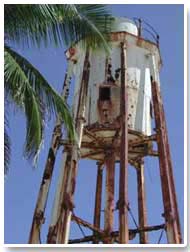 snorkel
and then to Half Moon Caye to have lunch and tour the caye. Both of these
are located in an area called the Lighthouse Reef Atoll.
snorkel
and then to Half Moon Caye to have lunch and tour the caye. Both of these
are located in an area called the Lighthouse Reef Atoll.
The Lighthouse Reef Atoll is really six cayes and is the farthest atoll
from the Belizean shore. The  area
is famous to divers as it offers some of the best underwater visibility
anywhere. Of the six cayes, only two of them are actually inhabited by people—the
Half Moon Caye and the Northern Caye. According to the guidebook, the other
four are home to only crocodiles and mosquitoes.
area
is famous to divers as it offers some of the best underwater visibility
anywhere. Of the six cayes, only two of them are actually inhabited by people—the
Half Moon Caye and the Northern Caye. According to the guidebook, the other
four are home to only crocodiles and mosquitoes.
One of Mario’s guides, Roy, and his six-year old son, Ryan, picked
us up around 8 in the morning. We traveled for about an hour across azure
colored water. The sky was blue and clear. We watched in amazement as flying
fish literally leapt out of the water and “flew” rapidly along
the surface of the ocean for close to 100 yards. They are able to flap their
pectoral fins which make them look like tiny birds. Occasionally, a spotted
eagle ray would break the ocean surface. On the horizon, we could see the
remains of a tanker that had shipwrecked on the outer reef.
Anyone sitting in the front of the boat got bounced around as the boat slapped
the waves. We laughed and made jokes about how hard it was to hang on and
not land on someone else’s lap. We traveled for about an hour before
coming to Turneffe Atoll, about halfway to Lighthouse Reef  Atoll.
Inside the Turneffe Atoll we wound through mangrove islands similar to the
Drowned Cayes where we are staying.
Atoll.
Inside the Turneffe Atoll we wound through mangrove islands similar to the
Drowned Cayes where we are staying.
As we came out the other side of these islands and back into open water,
Roy stopped the boat, pulled the floatation cushions out, and handed them
to us to sit on. He said, “From here on out, the water might become
rough.” We wondered, “how much more rough could it possibly be?”
But we followed directions, and put the cushions underneath us. Roy started
out across the open water. Suffice it to say, that the remaining portion
of the trip was not unlike riding a bucking bronco. We were very thankful
for the cushions.
The Blue Hole
At the center of the Lighthouse Reef Atoll is the famous Blue Hole. The
Blue Hole is really a “sinkhole”, the collapsed roof of an extensive
cave system now mostly under the ocean. The Blue Hole is 122 m (400 feet)
deep and 305 m (1000 feet) across.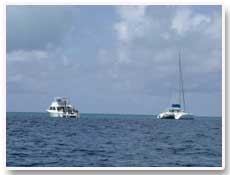 The rim of the hole is underwater and covered with reef. Divers from all
over the world come to explore this area because it is so rich in sea life,
as well as to descend into the marine cave system. When we arrived, there
were two other boats anchored in the hole.
The rim of the hole is underwater and covered with reef. Divers from all
over the world come to explore this area because it is so rich in sea life,
as well as to descend into the marine cave system. When we arrived, there
were two other boats anchored in the hole.
The first fish we encountered after jumping in was a six-foot barracuda!
Floating on the surface, we could watch the scuba divers down below us.
Roy took us on a snorkel tour of the reef wall for close to an hour. After
a short break on board to “refuel” with water and snacks, we snorkeled
for another hour and a half. Some of us decided to explore the outer reef
wall in the hopes of seeing sharks. No, we never did see any! Some of us
were disappointed—and some of us weren't.
Once back on board we compared notes on all the life we had seen. There
were schools of Blue tangs swimming on the outer reef, spotted eagle rays,
Spanish hogfish, Stoplight parrotfish, Peterson cleaning fish, Sergeant
majors and dozens more. This is one of the world’s best snorkeling
areas and we all felt privileged to spend the morning there. After snorkeling,
we headed to Half Moon Caye for lunch.
Half Moon Caye
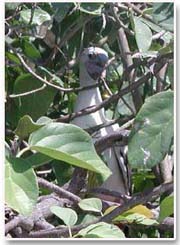 Half
Moon Caye is home to the rare, red-footed booby. Half Moon Caye was Belize’s
first
Half
Moon Caye is home to the rare, red-footed booby. Half Moon Caye was Belize’s
first  protected
area in 1928 largely because of the these birds. It is now a sanctuary for
them. Both because of the boobies and the Blue Hole, Half Moon Caye is a
World Heritage Site.
protected
area in 1928 largely because of the these birds. It is now a sanctuary for
them. Both because of the boobies and the Blue Hole, Half Moon Caye is a
World Heritage Site.
There are over 4000 boobies that live on the caye for ten months out of
the year. They nest in November and lay their eggs in December. Both parents
incubate one egg per nest, for seven weeks. The young remain in the nest
until July. Boobies are named after their behavior. Apparently, when hungry
seamen approached their remote breeding islands the birds were curious rather
than alarmed. Unfortunately, this made them very easy to catch. They are
now very rare in the Atlantic region.
The endangered Loggerhead and Hawksbill sea turtles both lay their eggs
on the beaches of Half Moon Caye. Unfortunately we did not get a chance
to see these magnificent creatures. One and two foot iguanas were quite
common, however.
 After
lunch we walked along a path to the sanctuary where there is a 12-foot observation
After
lunch we walked along a path to the sanctuary where there is a 12-foot observation platform that looks out over the Ziricote forest area where the boobies
nest. Everywhere we looked, we could see boobies sitting on tree branches.
They are difficult to see even though they are large birds. Magnificent
Frigate birds flew overhead attempting to steal the boobies’ eggs and
nesting chicks.
platform that looks out over the Ziricote forest area where the boobies
nest. Everywhere we looked, we could see boobies sitting on tree branches.
They are difficult to see even though they are large birds. Magnificent
Frigate birds flew overhead attempting to steal the boobies’ eggs and
nesting chicks.
It looked like a scene out of prehistory with hundreds of boobies sitting
in trees and the pterodactyl-looking frigates with their seven-foot wingspan
flying overhead and squawking. We have seen many of these birds while out
on the boat. They always appear to be hovering motionless in the air, yet
they are poor divers and cannot land on water. One way of acquiring food
is to prey on the young of other birds.
The Orange Flowered Ziricote (Cordia sebestena) is a native hardwood found
on the island. The tree is know locally as Cericote or Geiger tree. Its
beautiful, dark grained wood was traditionally used for wood cravings. What
is interesting about this tree is that it is the primary climax species
that is typical of mature sand cayes. A climax species is the species in
an environment that dominates after a period of competition and succession
between native species. The dense vegetation is supported by guano 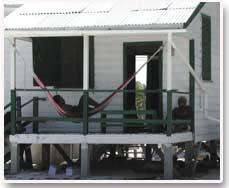 (bird
droppings) from the booby rookery that enriches the soil.
(bird
droppings) from the booby rookery that enriches the soil.
Also on the island is the Gumbo Limbo (Bursera simaruba) tree. The local
name however, is the “tourist tree” since its red shaggy bark
is always peeling! It grows 25 m tall with leaves that are five to 12 cm
long. The bark is a common tropical remedy for skin afflictions like sunburn,
sores, insect bites, etc. It is also taken internally to purify the blood.
The island also houses two lighthouses—one of which is no longer used.
We stopped and talked to the rangers who were resting on their porch after
lunch. They live on the caye for three weeks at a time then return to Belize
City for a week before coming back out to the caye for another three weeks.
They said that the caye has no mosquitoes or black flies. Sounds like paradise
to us!
Green Moray Eel
After lunch we headed out to an area in the bay nicknamed the Aquarium.
This is another area that is great for snorkeling because of the large schools
of Yellowtailed snapper and Horseye jack. Roy threw out pieces of bread
while we were in the water. We were literally swimming in the middle of
the school as they raced to gobble up the bread in a feeding frenzy.
Shelly, Caryn, Kevin, and Michael saw a six-foot green moray eel and were
all following it as it swam near the boat. Kevin dove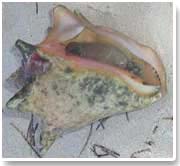 to the bottom to take a close picture of the eel and the normally docile
eel turned around to face him, opening its dog-sized jaws. From the boat,
all we heard was a loud muffled guffaw through snorkel tubes. Apparently,
Kevin’s reaction was pretty funny.
to the bottom to take a close picture of the eel and the normally docile
eel turned around to face him, opening its dog-sized jaws. From the boat,
all we heard was a loud muffled guffaw through snorkel tubes. Apparently,
Kevin’s reaction was pretty funny.
The Aquarium is characterized by long channels of sediment
separated by elongated fingers of coral reef mounds called “spur and
groove”. The forereef slope dips gently outward toward the edge of
the shelf. At the rim of the slope is an abrupt edge or “wall”,
where the bottom drops off dramatically. It looks like an underwater cliff.
Where the forereef meets the reef itself the water may be 10 to 15 feet
deep and at the wall edge, it is between 25 and 30 feet.
The slope beyond the cliff edge can be as high as 60 degrees. The water
over the wall edge is surprisingly cooler in contrast with the normally
warm water over the reef. There is also a distinct color difference in the
water. As you look down into the almost limitless ocean depths, the water
turns dark blue and reminds you of outer space. For the inexperienced diver
this “edge” can be very intimidating. It is easy to envision huge
sea creatures rising up out of the dark blue depths. You cannot help but
feel small and insignificant in comparison, and very vulnerable.
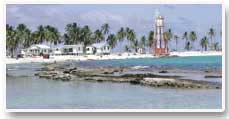 The
forereef slope meets the reef itself at a distinct wall of coral mounds
that grow to just under the low water mark. This formation is called the
reefcrest. The reefcrest is an extensive flat area characterized by a variety
of coral types that collectively create a marine “forest”. The
reefcrest extends for miles down the coast of Belize, separating the environments
into exposed forereef, reefcrest, and protected back reef. For snorkelers
this is the best area to explore as there is so much sea life living among
the reefcrest.
The
forereef slope meets the reef itself at a distinct wall of coral mounds
that grow to just under the low water mark. This formation is called the
reefcrest. The reefcrest is an extensive flat area characterized by a variety
of coral types that collectively create a marine “forest”. The
reefcrest extends for miles down the coast of Belize, separating the environments
into exposed forereef, reefcrest, and protected back reef. For snorkelers
this is the best area to explore as there is so much sea life living among
the reefcrest.
This protective arrangement is known as a barrier reef. The Belize Barrier
Reef system extends down almost the entire coastline of the country and
is the second largest barrier reef in the world—surpassed only by the
Great Barrier Reef of Australia. The mangrove cayes that extend throughout
coastal Belize owe their existence to the protection of this barrier reef.
Hannah, the Mermaid
 Hannah,
by the way, is an amazing diver—snorkeling to depths of 20 to 30 feet.
She has a rather unique style of swimming. Instead of kicking her legs and
flippers independently, she moves them in unison as a mermaid would. As
a matter of fact, she looks just like one when she dives, minus the fish
scales of course. We are all in awe of her. She said she learned to snorkel
here during her internship. We find that hard to believe, as it appears
she was born in water.
Hannah,
by the way, is an amazing diver—snorkeling to depths of 20 to 30 feet.
She has a rather unique style of swimming. Instead of kicking her legs and
flippers independently, she moves them in unison as a mermaid would. As
a matter of fact, she looks just like one when she dives, minus the fish
scales of course. We are all in awe of her. She said she learned to snorkel
here during her internship. We find that hard to believe, as it appears
she was born in water.
After diving in the Aquarium, we headed home. Thankfully the water was not
as rough. We explored a few of the mangrove areas back in Turneffe Atoll
because Caryn wanted to look for evidence of manatees. She saw what looked
like feeding scars in the turtle grass beds but we didn’t find any
manatees. Two dolphins appeared in a narrow channel and they played around
and under the boat for several minutes. Eventually they got bored perhaps
and headed off to who knows where.
We finally headed back and arrived home at dusk, exhausted but very satisfied
after our wonderful adventure.
![]()